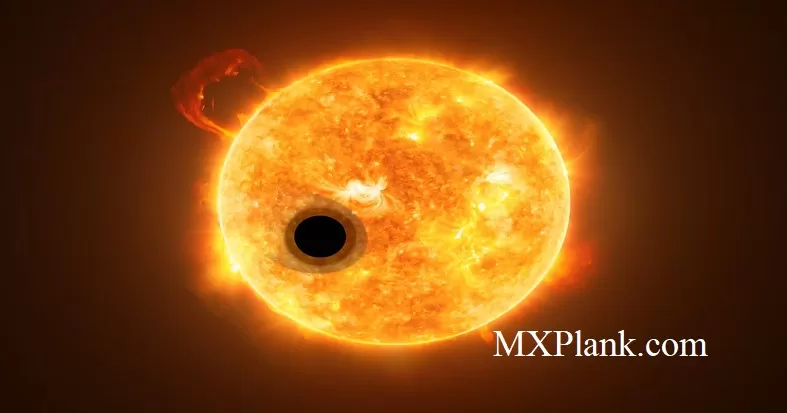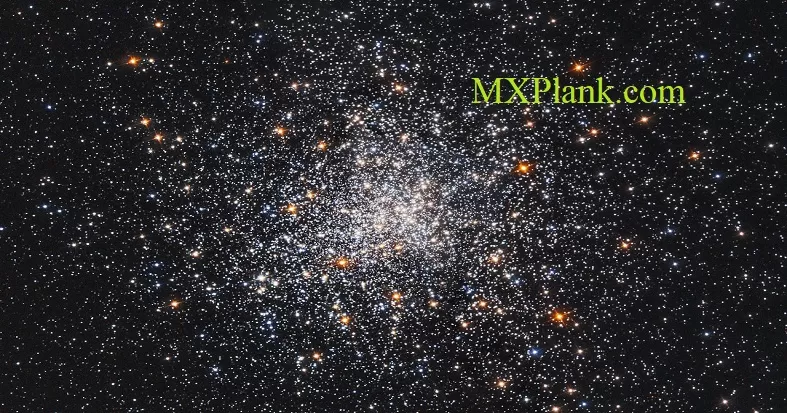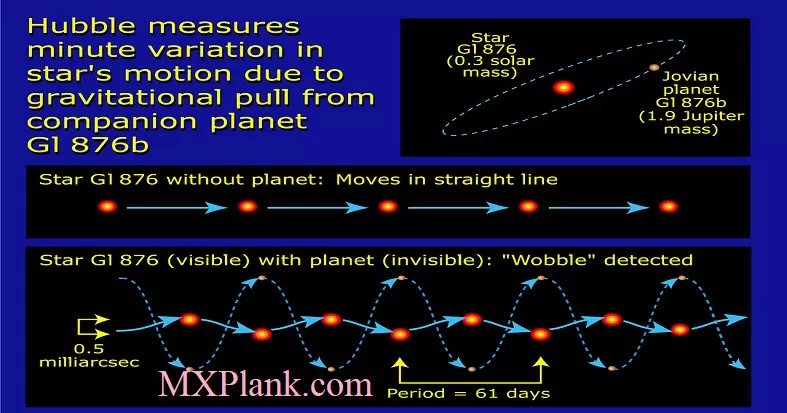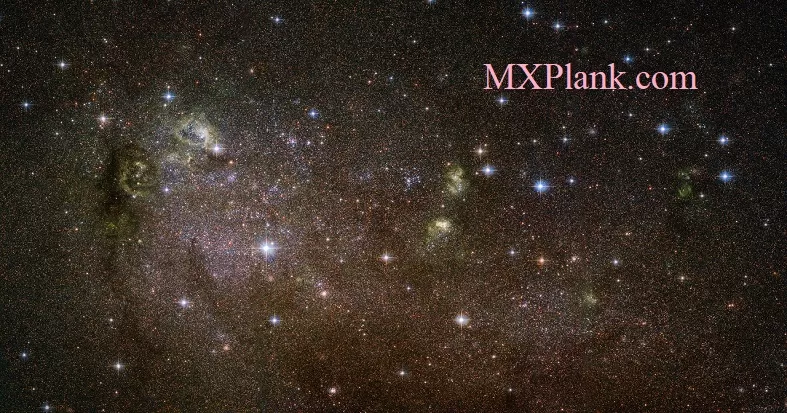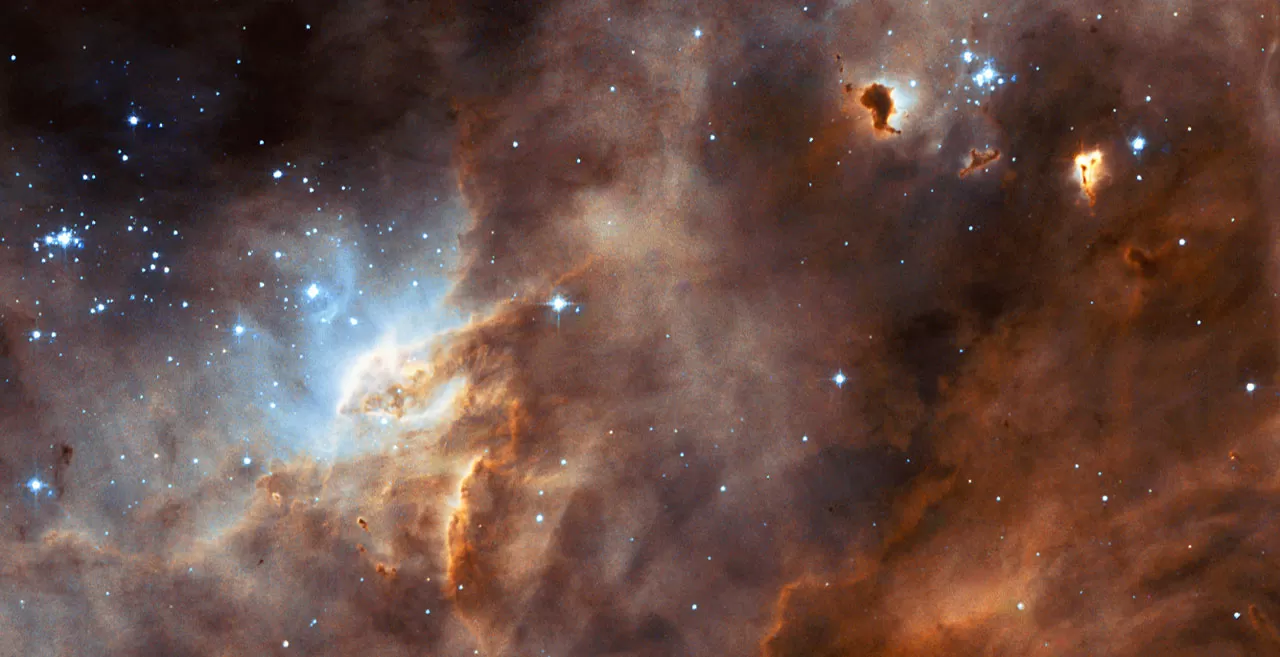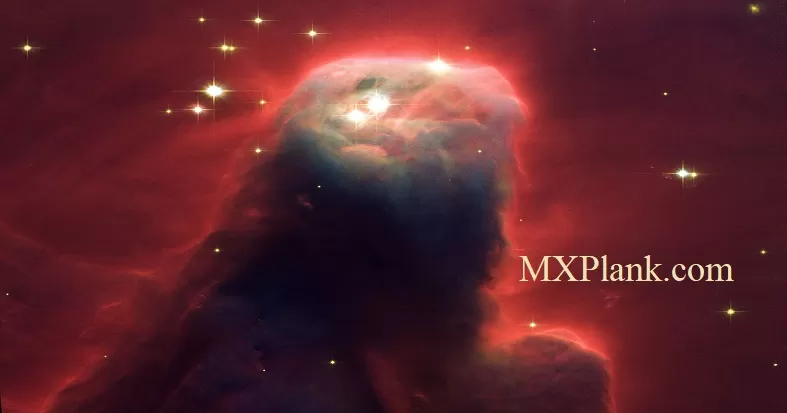Information Theory Of The Cosmos
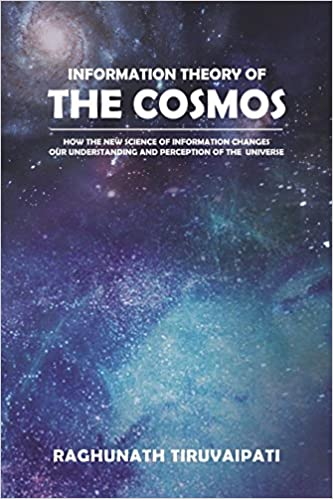
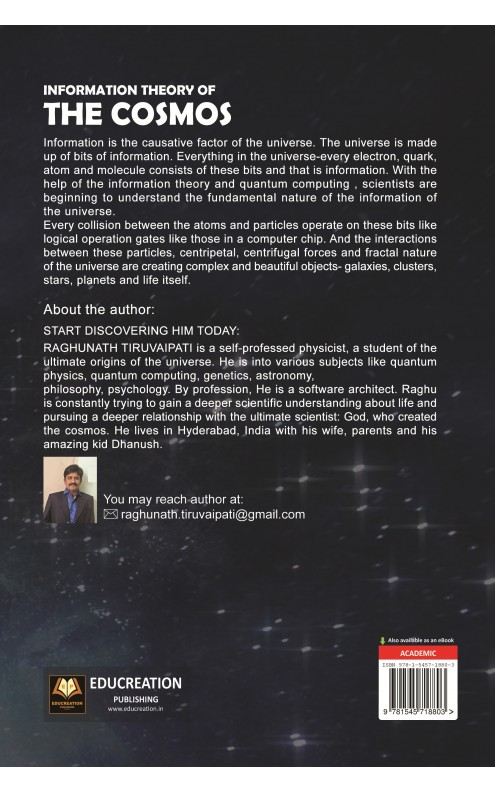
Description
This book deals with information theory spanning across different areas of science such as Quantum Physics, Quantum Computing, Genetics, Thermodynamics.
It describes how information underlies everything in the universe and the relationship between entropy of the universe and information.
it takes into account Shannon's information theory introduced in 1948 and discusses contemporary developments in the information theory field.
it discusses how the universe originated from bigbang and how life evolved for the last 4.5 billion years that the Earth was formed.
More over, it deals with new concepts in the field of quantum physics like quantum entanglement and quantum tunneling .
it also discusses the possibilities of sending information at the speed of light or more than that. it describes the Boltzmann's equations for stastical systems, maxwell's daemon, turing machine. this book touches upon a little bit of mathematic equations to explain about the quantum computing, how to build quantum logic gates and further developments in that field . it talks about astronomical objects like blackholes, quasars and the thermo-dynamics operating behind them. it touches upon genetics as genes carry a huge amount of information in their DNA to shape up an organism.
it also discusses the possibilities of sending information at the speed of light or more than that. it describes the Boltzmann's equations for stastical systems, maxwell's daemon, turing machine. this book touches upon a little bit of mathematic equations to explain about the quantum computing, how to build quantum logic gates and further developments in that field . it talks about astronomical objects like blackholes, quasars and the thermo-dynamics operating behind them. it touches upon genetics as genes carry a huge amount of information in their DNA to shape up an organism.
Cover page-back side description:
Information is the causative factor of the universe. The universe is made up of bits of information.
Everything in the universe-every electron, quark, atom and molecule consists of these bits and that is information.
With the help of the information theory and quantum computing , scientists are beginning to understand the fundamental nature of the information of the universe.
Every collision between the atoms and particles operate on these bits like logical operation gates like those in a computer chip. And the interactions between these particles, centripetal, centrifugal forces and fractal nature of the universe are creating complex and beautiful objects- galaxies, clusters, stars, planets and life itself.
Every collision between the atoms and particles operate on these bits like logical operation gates like those in a computer chip. And the interactions between these particles, centripetal, centrifugal forces and fractal nature of the universe are creating complex and beautiful objects- galaxies, clusters, stars, planets and life itself.
Contents:
- Prologue
- Cryptography
- Thermodynamics
- Information theory
- Genetic Code
- Cosmology
- Life on Earth
- Astronomy
- Relativity
- Quantum Computing
- Quantum Entanglement & Quantum Tunneling
- Epilogue
Sample Papers
Page-96
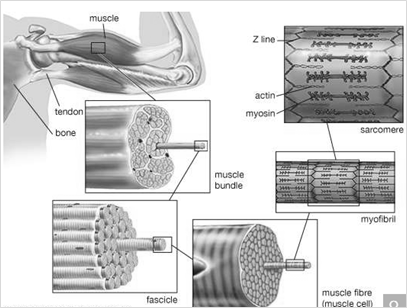
Striated muscle tissue, such as the tissue of the human biceps muscle, consists of long, fine fibres, each of which is in effect a bundle of finer myofibrils. Within each myofibril are filaments of the proteins myosin and actin; these filaments slide past one another as the muscle contracts and expands. On each myofibril, regularly occurring dark bands, called Z lines, can be seen where actin and myosin filaments overlap. The region between two Z lines is called a sarcomere; sarcomeres can be considered the primary structural and functional unit of muscle tissue.
Actin is also present in non-muscle cells, where it forms a meshwork of filaments responsible for many types of cellular movement. The meshwork consists of actin filaments that are attached to the cell membrane and to each other. The length of the filaments and the architecture of their attachments determine the shape and consistency of a cell. A large number of accessory proteins bind to actin, controlling the number, length, position, and attachments of the actin filaments. Different cells and tissues contain different accessory proteins, which accounts for the different shapes and movements of different cells. For example, in some cells, actin filaments are bundled by accessory proteins, and the bundle is attached to the cell membrane to form microvilli, stable protrusions tha
Actin is also present in non-muscle cells, where it forms a meshwork of filaments responsible for many types of cellular movement. The meshwork consists of actin filaments that are attached to the cell membrane and to each other. The length of the filaments and the architecture of their attachments determine the shape and consistency of a cell. A large number of accessory proteins bind to actin, controlling the number, length, position, and attachments of the actin filaments. Different cells and tissues contain different accessory proteins, which accounts for the different shapes and movements of different cells. For example, in some cells, actin filaments are bundled by accessory proteins, and the bundle is attached to the cell membrane to form microvilli, stable protrusions tha
Page-62
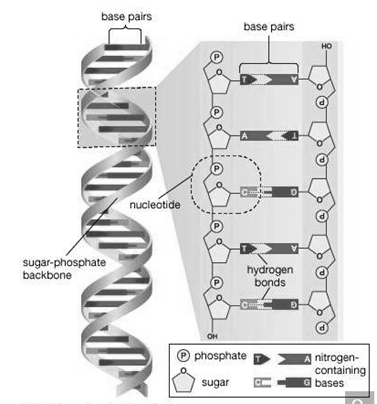
The four nucleotide bases are adenine, cytosine, guanine, and thymine. DNA is composed of millions of these bases strung in an apparently limitless variety of sequences. It is in the sequence of bases that the genetic information is contained, each sequence determining the sequence of amino acids to be connected into proteins.
A nucleotide sequence sufficient to encode one protein is called a gene. Genes are interspersed along the DNA molecule with other sequences that do not encode proteins. Some of these so-called untranslated regions regulate the activity of the adjacent genes, for example, by marking the points at which enzymes begin and cease transcribing DNA into RNA.
A nucleotide sequence sufficient to encode one protein is called a gene. Genes are interspersed along the DNA molecule with other sequences that do not encode proteins. Some of these so-called untranslated regions regulate the activity of the adjacent genes, for example, by marking the points at which enzymes begin and cease transcribing DNA into RNA.
Page-117
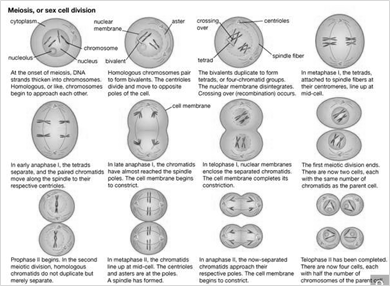
Meiosis:
A specialized division of chromosomes called meiosis occurs during the formation of the reproductive cells, or gametes, of sexually reproducing organisms. Gametes such as ova, sperm, and pollen begin as germ cells, which, like other types of cells, have two copies of each gene in their nuclei.
The chromosomes composed of these matching genes are called homologs. During DNA replication, each chromosome duplicates into two attached chromatids. The homologous chromosomes are then separated to opposite poles of the meiotic spindle by microtubules similar to those of the mitotic spindle. At this stage in the meiosis of germ cells, there is a crucial difference from the mitosis of other cells.
In meiosis the two chromatids making up each chromosome remain together, so that whole chromosomes are separated from their homologous partners. Cell division then occurs, followed by a second division that resembles mitosis more closely in that it separates the two chromatids of each remaining chromosome. In this way, when meiosis is complete, each mature gamete receives only one copy of each gene instead of the two copies present in other cells.
The chromosomes composed of these matching genes are called homologs. During DNA replication, each chromosome duplicates into two attached chromatids. The homologous chromosomes are then separated to opposite poles of the meiotic spindle by microtubules similar to those of the mitotic spindle. At this stage in the meiosis of germ cells, there is a crucial difference from the mitosis of other cells.
In meiosis the two chromatids making up each chromosome remain together, so that whole chromosomes are separated from their homologous partners. Cell division then occurs, followed by a second division that resembles mitosis more closely in that it separates the two chromatids of each remaining chromosome. In this way, when meiosis is complete, each mature gamete receives only one copy of each gene instead of the two copies present in other cells.
Page-90
More-complex genetic changes have been documented, leading to special locally adapted "ecotypes." Anoles (a type of lizard) on certain Caribbean islands show convincing examples of adaptations to specific habitats, such as tree trunks, tree branches, or grass. Introductions of lizards onto uncolonized islands result in demonstrable microevolutionary adaptations to the various vacant niches.
On the Galapagos Islands, studies over several decades have documented adaptive changes in the beaks of finches. In some studies, documented changes have led to incipient new species. An example is the apple maggot, the larva of a fly in North America that has evolved from a similar fly living on hawthorns-all in the period since the introduction of apples.
The formation of new species was a key component of Darwin's original theory. Now it appears that the accumulation of enough small-scale genetic changes can lead to the inability to mate with members of an ancestral population; such reproductive isolation is the key step in species formation
On the Galapagos Islands, studies over several decades have documented adaptive changes in the beaks of finches. In some studies, documented changes have led to incipient new species. An example is the apple maggot, the larva of a fly in North America that has evolved from a similar fly living on hawthorns-all in the period since the introduction of apples.
The formation of new species was a key component of Darwin's original theory. Now it appears that the accumulation of enough small-scale genetic changes can lead to the inability to mate with members of an ancestral population; such reproductive isolation is the key step in species formation
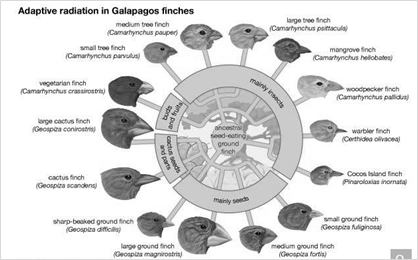
Fourteen species of Galapagos finches that evolved from a common ancestor. The different shapes of their bills, suited to different diets and habitats, show the process of adaptive radiation. It is reasonable to assume that the continuation of microevolutionary genetic changes over very long periods of time can give rise to new major taxonomic groups, the process of macroevolution. There are few data that bear directly on the
Page-90
The Differentiated State
The biochemical basis of cell differentiation is the synthesis by the cell of a particular set of proteins, carbohydrates, and lipids. This synthesis is catalyzed by proteins called enzymes.
Each enzyme in turn is synthesized in accordance with a particular gene, or sequence of nucleotides in the DNA of the cell nucleus. A particular state of differentiation, then, corresponds to the set of genes that is expressed and the level to which it is expressed.
The biochemical basis of cell differentiation is the synthesis by the cell of a particular set of proteins, carbohydrates, and lipids. This synthesis is catalyzed by proteins called enzymes.
Each enzyme in turn is synthesized in accordance with a particular gene, or sequence of nucleotides in the DNA of the cell nucleus. A particular state of differentiation, then, corresponds to the set of genes that is expressed and the level to which it is expressed.
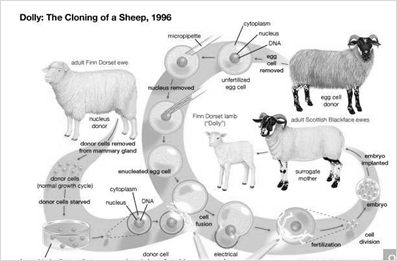
Dolly the sheep was successfully cloned in 1996 by fusing the nucleus from a mammary-gland cell of a Finn Dorset ewe into an enucleated egg cell taken from a Scottish Blackface ewe. Carried to term in the womb of another Scottish Blackface ewe, Dolly was a genetic copy of the Finn Dorset ewe.
It is believed that all of an organism's genes are present in each cell nucleus, no matter what the cell type, and that differences between tissues are not due to the presence or absence of certain genes but are due to the expression of some
It is believed that all of an organism's genes are present in each cell nucleus, no matter what the cell type, and that differences between tissues are not due to the presence or absence of certain genes but are due to the expression of some

